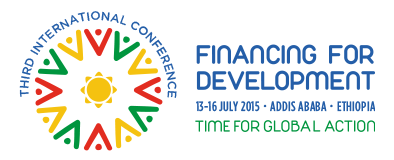In a blog launched as part of preparations for the Third International Conference on Financing for Development (FfD 3), contributions from experts and officials highlight the need to raise sufficient funds for health by tapping into new sources and improving cost efficiencies, and to have a common understanding of “what we are talking about” when it comes to discussing innovative financing.
 11 June 2015: In a blog launched as part of preparations for the Third International Conference on Financing for Development (FfD 3), contributions from experts and officials highlight the need to raise sufficient funds for health by tapping into new sources and improving cost efficiencies, and to have a common understanding of “what we are talking about” when it comes to discussing innovative financing.
11 June 2015: In a blog launched as part of preparations for the Third International Conference on Financing for Development (FfD 3), contributions from experts and officials highlight the need to raise sufficient funds for health by tapping into new sources and improving cost efficiencies, and to have a common understanding of “what we are talking about” when it comes to discussing innovative financing.
In an article on finding new financing for sustaining health in the post-Millennium Development Goals world, Margaret Chan, World Health Organization (WHO) Director-General, underscores the economic benefits of investing in health. Chan notes that investing in reproductive and maternal and child health has a potential return of more than US$20 for every dollar spent. She further indicates that the estimated cost of reducing the non-communicable diseases (NCDs) burden in developing countries has been estimated at US$11 billion, from 2011-2025.
She stresses the need to: accelerate action to combat infectious diseases; prevent and respond to NCDs and new and sudden health challenges like Ebola; improve maternal and children health; ensure availability of finances to ensure access to health services and achieve universal health coverage (UHC) in “every community in every country of the world”; and expand “the focus to confront health challenges that were hidden, misunderstood, under-reported or overshadowed, so that no one will be left behind.” Noting that 70% of the world’s poor live in middle-income countries (MICs) today, she says richer countries should provide catalytic support to enable low- and middle-income countries to develop and complement robust “home-grown solutions.”
Andrew Wainer, Save the Children US, observes that while innovative finance is one of the “most-discussed among the multitude of development financing tools,” there is no common definition of this tool and, in some cases, the various definitions are diametrically opposed. For instance, a version of the draft FfD 3 outcome document uses innovative finance in the context of “Financial transaction tax, carbon taxes… taxes on fuels used in international aviation and maritime activities, or additional tobacco taxes,” whereas the US Agency for International Development (USAID) almost always uses innovative financing in relation to collaboration with the private sector, not new taxes, the author says.
Wainer calls for: using the Addis Ababa outcome as a platform for a more meaningful and actionable understanding of innovative finance; ensuring that this type of finance adheres to the core principles of transparency, accountability, and alignment with developing nations’ priorities; and, in the long term, testing and evaluating models, and sharing results among the diverse organizations working on innovative finance.
FfD 3 convenes in Addis Ababa, Ethiopia, on 13-16 July 2015. [Margaret Chan Post] [Andrew Wainer Post] [Previous IISD RS Story on FfD3 Blog] [FfD3 Website]